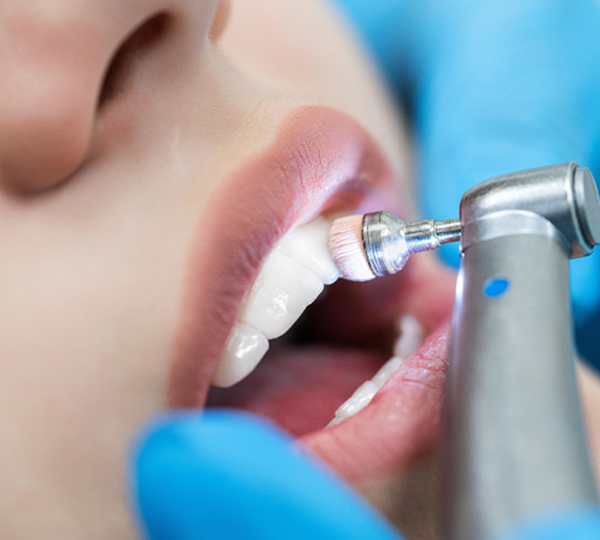Tooth Cleaning
Dental cleanings are essential for maintaining optimal oral health. They involve a thorough cleaning of your teeth and gums by one of our professionally trained and certified dental hygienists. This process helps remove plaque, tartar, and stains that regular brushing and flossing cannot eliminate.
Here’s a detailed look at what typically happens during a dental cleaning:
The procedure usually begins with a physical examination of your mouth. The dental hygienist uses a small mirror to check around your teeth and gums for any signs of gingivitis or other potential concerns. If any major issues are detected, the hygienist might call in the dentist for a closer look.
Next, the hygienist uses a scaler to remove plaque and tartar around your gum line and between your teeth. You might hear scraping sounds, but this is normal. The more tartar there is in your mouth, the more time they need to spend scraping a particular spot. Tartar, also known as calculus, is hardened plaque that can only be removed during professional cleanings.
After the tartar is removed, the hygienist uses a high-powered electric brush and gritty toothpaste to clean your teeth. This process, known as polishing, helps remove any remaining tartar and stains. It’s safe to have this done twice a year, but not more frequently, as it can wear down the enamel.
Following the polishing, the hygienist will floss your teeth to ensure that all areas between your teeth are clean. This step also helps identify any potential trouble spots where your gums might bleed.
Finally, you might receive a fluoride treatment. Fluoride is a mineral that helps strengthen the enamel and protect your teeth from cavities. The treatment involves applying a varnish or sticky paste to your teeth, which is left on for a minute or so.
Regular dental cleanings, recommended every six months, are crucial for preventing gum disease, cavities, and other oral health issues. They also help maintain a bright, healthy smile and fresh breath.

Here’s a detailed look at what typically happens during a dental cleaning:
The procedure usually begins with a physical examination of your mouth. The dental hygienist uses a small mirror to check around your teeth and gums for any signs of gingivitis or other potential concerns. If any major issues are detected, the hygienist might call in the dentist for a closer look.
Next, the hygienist uses a scaler to remove plaque and tartar around your gum line and between your teeth. You might hear scraping sounds, but this is normal. The more tartar there is in your mouth, the more time they need to spend scraping a particular spot. Tartar, also known as calculus, is hardened plaque that can only be removed during professional cleanings.
After the tartar is removed, the hygienist uses a high-powered electric brush and gritty toothpaste to clean your teeth. This process, known as polishing, helps remove any remaining tartar and stains. It’s safe to have this done twice a year, but not more frequently, as it can wear down the enamel.
Following the polishing, the hygienist will floss your teeth to ensure that all areas between your teeth are clean. This step also helps identify any potential trouble spots where your gums might bleed.
Finally, you might receive a fluoride treatment. Fluoride is a mineral that helps strengthen the enamel and protect your teeth from cavities. The treatment involves applying a varnish or sticky paste to your teeth, which is left on for a minute or so.
